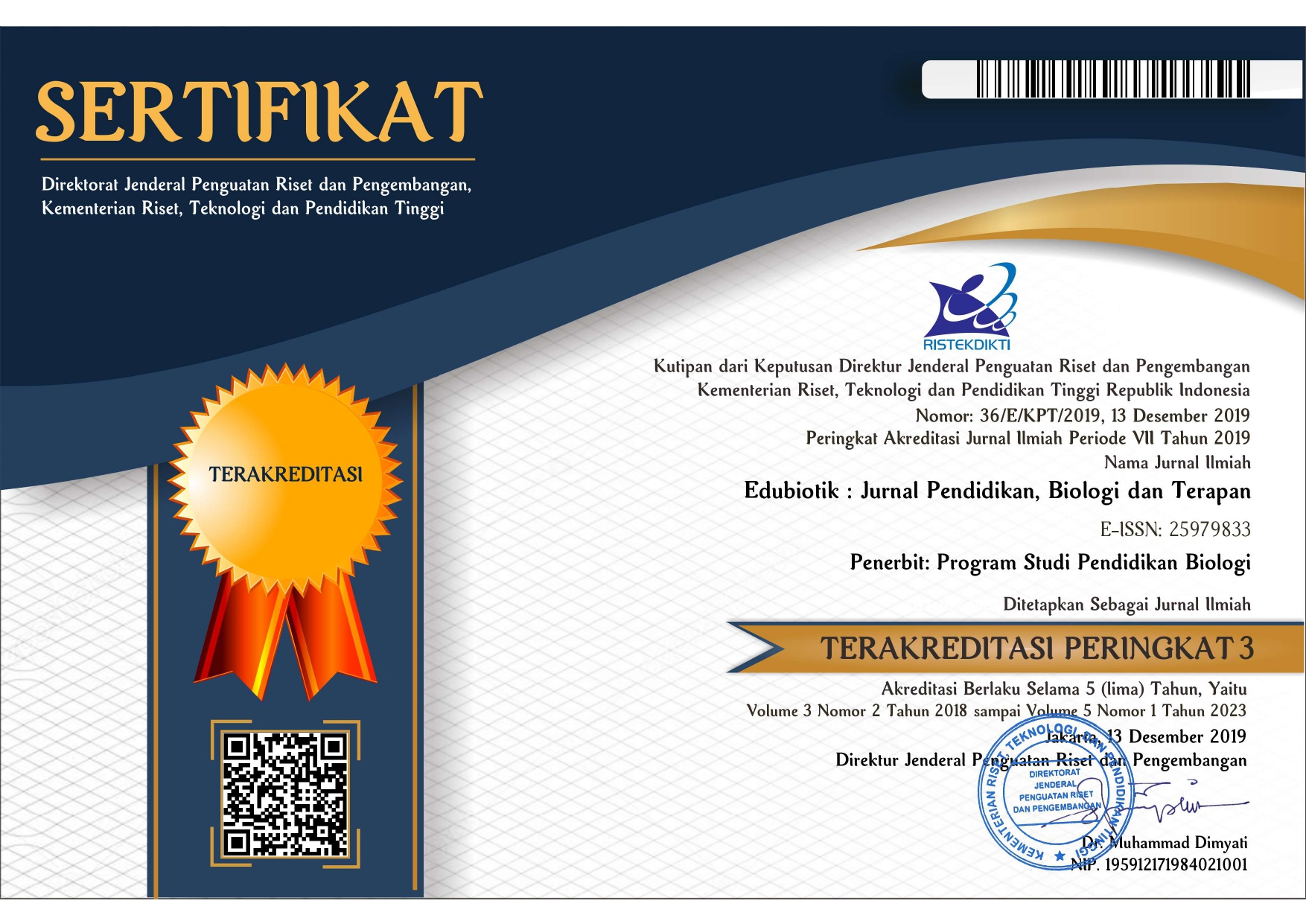Botanical application: Android-based learning media to enhance interest in learning plant material
Abstract
Balikpapan Botanical Garden School has a very supportive learning environment, especially in studying plant material, but there are still many students who show low interest in learning so that an application in the form of android application to foster student interest in learning related to plants. This research aims to determine the feasibility of the botanical application as the further development of a flash application with the same theme to enhance interest in learning plant material. This research is used Research and Development (R&D) with ADDIE model which includes the analysis, design, development, implementation, and evaluation stage. The data were collected using a questionnaire to measure students’ learning referring to Mitchell's theory with 25 questions. The result showed that the botanical application is feasible to use with a score of 3,86 (feasible) and 4,16 (very feasible) according to media and material experts, and also a score of 4,47 (very feasible) according to the students. It also can enhance interest in learning plant material at the significance level of 0.002<0.05 with 46,6% of students reach the high criterion and the other 53,3% reach the moderate criterion of interest. This android-based of botanical application turns out to be able to enhance interest in learning about plant material due to learners' option to choose learning content depending on their interest.
References
Abusharib, A. B., Nourein, I. H., & Huneif, M. A. (2015). Limitations and Pitfalls of PowerPoint Presentations : Najran University Medical Students’ Point of View. Global Advanced Research Journal of Educational Research and Review, 4(3), 43–47. Retrieved from https://www.academia.edu/11765173/
Alomary, A., Woollard, J., & Evans, C. (2016). To Use or Not To Use: Mobile Learning? Proceedings of Academics World 27th International Conference, March, 32–35. Retrieved from https://www.researchgate.net/
Amjah, D. Y. P. H. (2014). A Study of Teachers’ Strategies so Develop Students’ Interest towards Learning English as a Second Language. Procedia - Social and Behavioral Sciences, 134, 188–192. https://doi.org/10.1016/j.sbspro.2014.04.238
Chen, S., & Xia, Y. (2012). Research on Application of Multimedia Technology in College Physical Education. Procedia Engineering, 29, 4213–4217. https://doi.org/10.1016/j.proeng.2012.01.645
Çimer, A. (2012). What Makes Biology Learning Difficult and Effective: Students’ Views. Educational Research and Reviews, 7(3), 61–71. https://doi.org/10.5897/ERR11.205
Erlina, D., Marzulina, L., Lingga, N., Astrid, A., Yansyah, F., & Mukminin, A. (2018). Research on Educational Media: Balancing between Local and Target Language Cultures in English Electronic Textbooks. TOJET: The Turkish Online Journal of Educational Technology, 17(2), 111–119. Retrieved from http://www.tojet.net/articles/v17i2/17211.pdf
Etobro, A. B., & Fabinu, O. E. (2017). Students’ Perceptions of Difficult Concepts in Biology in Senior Secondary Schools in Lagos State. Global Journal of Educational Research, 16(2), 139. https://doi.org/10.4314/gjedr.v16i2.8
Fauzi, A., & Mitalistiani, M. (2018). High School Biology Topics That Perceived Difficult By Undergraduate Students. DIDAKTIKA BIOLOGI: Jurnal Penelitian Pendidikan Biologi, 2(2), 73. https://doi.org/10.32502/dikbio.v2i2.1242
Harackiewicz, J. M., Smith, J. L., & Priniski, S. J. (2018). Interest Matters: The Importance of Promoting Interest in Education. Policy Insights Behav Brain Sci, 3(2), 220–227. https://doi.org/10.1177/2372732216655542
Lee, Y. J., Chao, C. H., & Chen, C. Y. (2011). The Influences of Interest in Learning and Learning Hours on Learning Outcomes of Vocational College Students in Taiwan: Using A Teacher’s Instructional Attitude as The Moderator. Global Journal of Engineering Education, 13(3), 140–153. Retrieved from http://wiete.com.au/journals/GJEE/Publish/vol13no3/01-Lee-Y-J.pdf
Liaw, S. S., & Huang, H. M. (2012). A Case of Study of Investigating Users’ Acceptance Toward Mobile Learning. Lecture Notes in Electrical Engineering, 157(2), 299–305. https://doi.org/10.1007/978-3-642-28798-5_41
McCarthy, J. (2014). Learner Interest Matters: Strategies for Empowering Student Choice. Retrieved from https://www.edutopia.org/blog/differentiated-instruction-learner-interest-matters-john-mccarthy
Mitchell, M. (1993). Situational Interest: Its Multifaceted Structure in The Secondary School Mathematics Classroom. Journal of Educational Psychology, 85(3), 424–436. https://psycnet.apa.org/doi/10.1037/0022-0663.85.3.424
Narayanasamy, F. S. (2013). Adaptation of Mobile Learning in Higher Educational Institutions of Saudi Arabia. International Journal of Computer Applications, 69(6), 34–38. http://dx.doi.org/10.5120/11847-7590
Nassuora, A. (2013). Students Acceptance of Mobile Learning for Higher Education in Saudi Arabia. International Journal of Learning Management Systems, 1(1), 1–9. https://doi.org/10.12785/ijlms/010101
Oktavian, R., & Aldya, R. F. (2020). Integrasi Pemanfaatan Media Pembelajaran Berbasis Adobe Flash dengan Lingkungan untuk Meningkatkan Minat Belajar Biologi. Inteligensi : Jurnal Ilmu Pendidikan, 3(1), 40–46. https://doi.org/10.33366/ilg.v3i1.1823
Raven, Johnson, Mason, Losos & Singer. (2017). Biology. USA: McGraw-Hill Education.
Roure, C., Kermarrec, G., & Pasco, D. (2019). Effects of Situational Interest Dimensions on Students’ Learning Strategies in Physical Education. European Physical Education Review, 25(2), https://doi.org/10.1177/1356336X17732964
Sabri, S., & Abdul, M. (2020). Integration of Dick and Carey Design in String Ensemble Class Instructional Material Design. International Journal of Innovation, Creaivity and Change, 14(11), 359–388. Retrieved from https://www.ijicc.net/images/Vol_14/Iss_11/141125_Sabri_2020_E1_R.pdf
Said, K., Kurniawan, A., & Anton, O. (2018). Development of Media-Based Learning Using Android Mobile Learning. Journal of Theoretical and Applied Information Technology, 96(3), 668–676. Retrieved from https://www.researchgate.net/
Sitanggang, N., Luthan, P. L. A., & Jeumpa, K. (2019). The Effect of Using Real-Object Media on The Students’ Interest in Cost Estimation Learning. Jurnal Pendidikan Teknologi dan Kejuruan, 25(1), 68–77. https://doi.org/10.21831/jptk.v25i1.22190
Sithole, N. (2017). Promoting A Positive Learning Environment: School Setting Investigation, University of South Africa. Pretoria, 1–105. Retrieved from http://uir.unisa.ac.za/handle/10500/24348
Tan, H. Y. J., Kwok, J. W. J., Neo Dr., M., & Neo Dr., T. K. (2010). Enhancing Student Learning Using Multimedia and Web Technologies: Students’ Perceptions of An Authentic Learning Experience in A Malaysian Classroom. The Australasian Society for Computers in Learning in Tertiary Education, June, 951–962. Retrieved from https://www.ascilite.org/conferences/sydney10/procs/Tan-full.pdf
Wallner, T., & Wagner, G. (2016). Academic Education 4.0. International Conference on Education and New Developments, June, 155–159. Retrieved from https://www.researchgate.net/
Wang, C. (2017). The Research on The Application of Plant Identification & Mobile Learning App Based on Expert System. Proceedings of the 9th International Conference on Computer Supported Education, 2(5), 332–339. https://doi.org/10.5220/0006313103320339
Wigfield, A., & Cambria, J. (2010). Students’ Achievement Values, Goal Orientations, and Interest: Definitions, Development, and Relations to Achievement Outcomes. Developmental Review, 30(1), 1–35. https://psycnet.apa.org/doi/10.1016/j.dr.2009.12.001
Yang, N. (2015). The Application of Multimedia Technology in College English Teaching. Proceedings of the International Conference on Management, Information and Educational Engineering, MIEE 2014, 787–789. https://doi.org/10.1201/b18558-182
Zhu, B., & Zhou, Y. (2012). A Study on Students’ Affective Factors in Junior High School English Teaching. English Language Teaching, 5(7), 33–41. https://doi.org/10.5539/elt.v5n7p33





.png)
2.png)

1.jpg)


